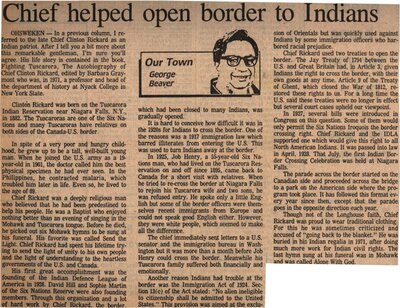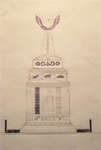"Chief Helped Open Border to Indians"
- Full Text
- Chief helped open border to Indians
OHSWEKEN - In a previous column, I referred to the late Chief Clinton Rickard as an Indian patriot. After I tell you a bit more about this remarkable gentleman, I'm sure you'll agree. His life story is contained in the book, Fighting Tuscarora, The Autobiography of Chief Clinton Rickard, edited by Barbara Graymont who was, in 1971, a professor and head of the department of history at Nyack College in New York State.
Clinton Rickard was born on the Tuscarora Indian Reservation near Niagara Falls, N.Y., in 1882. The Tuscaroras are one of the Six Nations and many Tuscaroras have relatives on both sides of the Canada-U.S. border.
In spite of a very poor and hungry childhood, he grew up to be a tall, well-built young man. When he joined the U.S. army as a 19-year-old in 1901, the doctor called him the best physical specimen he had ever seen. In the Philippines, he contracted malaria, which troubled him later in life. Even so, he lived to the age of 89.
Chief Rickard was a deeply religious man who believed that he had been predestined to help his people. He was a Baptist who enjoyed nothing better than an evening of singing in the Mohawk and Tuscarora tongue. Before he died, he picked out six Mohawk hymns to be sung at his funeral. His favorite was called Send the Light. Chief Rickard had spent his lifetime trying to send the light of understanding to the heartless governments of the U.S. and Canada.
His first great accomplishment was the founding of the Indian Defence League of America in 1926. David Hill and Sophie Martin of the Six Nations Reserve were also founding members. Through this organization and a lot of hard work by Chief Rickard, the border which had been closed to many Indians, was gradually opened.
It is hard to conceive how difficult it was in the 1920s for Indians to cross the border. One of the reasons was a 1917 immigration law which barred illiterates from entering the U.S. This was used to turn Indians away at the border.
In 1925, Job Henry, a 55-year-old Six Nations man, who had lived on the Tuscarora Reservation on and off since 1895, came back to Canada for a short visit with relatives. When he tried to re-cross the border at Niagara Falls to rejoin his Tuscarora wife and two sons, he was refused entry. He spoke only a little English but some of the border officers were themselves recent immigrants from Europe and could not speak good English either. However, they were white people, which seemed to make all the difference.
The chief immediately sent letters to a U.S. senator and the immigration bureau in Washington but it was more than a month before Job Henry could cross the border. Meanwhile his Tuscarora family suffered both financially and emotionally.
Another reason Indians had trouble at the border was the Immigration Act of 1924. Section 13(c) of the Act stated: "No alien ineligible to citizenship shall be admitted to the United States." This provision was aimed at the exclusion of Orientals but was quickly used against Indians by some immigration officers who harbored racial prejudice.
Chief Rickard used two treaties to open the border. The Jay Treaty of 1794 between the U.S. and Great Britain had, in Article 3, given Indians the right to cross the border, with their own goods at any time. Article 9 of the Treaty of Ghent, which closed the War of 1812, restored these rights to us. For a long time the U.S. said these treaties were no longer in effect but several court cases upheld our viewpoint.
In 1927, several bills were introduced in Congress on this question. Some of them would only permit the Six Nations Iroquois the border crossing right. Chief Rickard and the IDLA supported one which would give this right to all North American Indians. It was passed into law in April, 1928. That July, the first Indian Border Crossing Celebration was held at Niagara Falls.
The parade across the border started on the Canadian side and proceeded across the bridge to a park on the American side where the program took place. It has followed this format every year since then, except that the parade goes in the opposite direction each year.
Though not of the Longhouse faith, Chief Rickard was proud to wear traditional clothing. For this he was sometimes criticized and accused of "going back to the blanket." He was buried in his Indian regalia in 1971, after doing much more work for Indian civil rights. The last hymn sung at his funeral was in Mohawk and was called Alone With God.
- Mystery Question
- When was this article published?[Please answer by clicking on the Comments tab]
- Creator
- Beaver, George, Author
- Media Type
- Newspaper
- Item Types
- Articles
- Clippings
- Description
- "In a previous column, I referred to the late Chief Clinton Rickard as an Indian patriot. After I tell you a bit more about this remarkable gentleman, I'm sure you'll agree. His life story is contained in the book, Fighting Tuscarora, The Autobiography of Chief Clinton Rickard, edited by Barbara Graymont who was, in 1971, a professor and head of the department of history at Nyack College in New York State."
- Subject(s)
- Personal Name(s)
- Rickard, Clinton ; Graymont, Barbara ; Henry, Job ; Hill, David ; Martin, Sophie.
- Local identifier
- SNPL002554v00d
- Collection
- Scrapbook #1 by Janet Heaslip
- Language of Item
- English
- Geographic Coverage
-
-
New York, United States
Latitude: 43.16644 Longitude: -78.95726
-
- Creative Commons licence
 [more details]
[more details]- Copyright Statement
- Public domain: Copyright has expired according to Canadian law. No restrictions on use.
- Copyright Holder
- Brantford Expositor
- Contact
- Six Nations Public LibraryEmail:info@snpl.ca
Website:
Agency street/mail address:1679 Chiefswood Rd
PO Box 149
Ohsweken, ON N0A 1M0
519-445-2954



